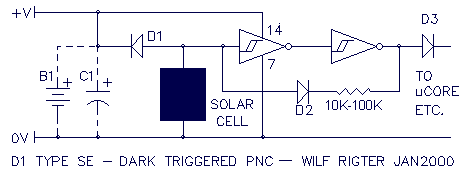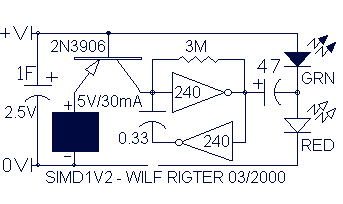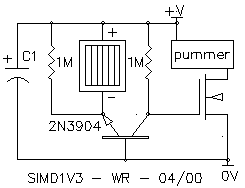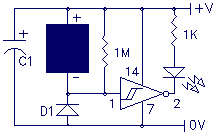
Wifl Rigter`s SIMD1 V0

It provides much quicker turn-on when the Sun goes down. Note that a smaller value for the resistor will provide faster turn-on; the trade-off is that a smaller value for the resistor also makes the solar engine less efficient at charging the capacitor (since we’re then losing more of our precious solar power through resistive losses in daylight). In any event, the SIMD1 V0 requires almost complete darkness in order to trigger.
The described circuit appears to be a solar-powered light activation system utilizing a solar engine, specifically the SIMD1 V0 model. This system is designed to turn on a light source when ambient light levels drop significantly, such as at dusk. The operation of the circuit hinges on the balance between the resistor value and the efficiency of the solar energy harvesting system.
In this setup, the solar panel collects sunlight during the day and converts it into electrical energy, which is used to charge a capacitor. The capacitor serves as an energy storage component, enabling the circuit to power a load (like an LED or other light source) during the night or in low-light conditions. The turn-on mechanism relies on a light-dependent resistor (LDR) or a phototransistor that detects the falling light levels.
The choice of resistor value in the circuit is crucial. A smaller resistor value will allow for a quicker response time, meaning the light will turn on almost instantaneously when darkness falls. However, this comes at the cost of efficiency, as a lower resistance can lead to increased resistive losses during the day. This inefficiency arises because more solar energy is dissipated as heat through the resistor rather than being stored in the capacitor for later use.
The SIMD1 V0's requirement for "almost complete darkness" indicates that the circuit is designed to minimize false triggering due to ambient light fluctuations. This feature ensures that the light only activates when it is genuinely needed, enhancing the system's overall functionality and efficiency.
For optimal performance, careful consideration must be given to the selection of the resistor and the capacitor values, as these components directly influence the circuit's response time and energy efficiency. Additionally, the solar panel's size and specifications should align with the expected energy demands of the load to ensure reliable operation throughout the night.It provides much quicker turn-on when the Sun goes down. Note that a smaller value for the resistor will provide faster turn-on; the trade-off is that a smaller value for the resistor also makes the solar engine less efficient at charging the capacitor (since we`re then losing more of our precious solar power through resistive losses in daylight). In any event, the SIMD1 V0 requires almost complete darkness in order to trigger. 🔗 External reference
The described circuit appears to be a solar-powered light activation system utilizing a solar engine, specifically the SIMD1 V0 model. This system is designed to turn on a light source when ambient light levels drop significantly, such as at dusk. The operation of the circuit hinges on the balance between the resistor value and the efficiency of the solar energy harvesting system.
In this setup, the solar panel collects sunlight during the day and converts it into electrical energy, which is used to charge a capacitor. The capacitor serves as an energy storage component, enabling the circuit to power a load (like an LED or other light source) during the night or in low-light conditions. The turn-on mechanism relies on a light-dependent resistor (LDR) or a phototransistor that detects the falling light levels.
The choice of resistor value in the circuit is crucial. A smaller resistor value will allow for a quicker response time, meaning the light will turn on almost instantaneously when darkness falls. However, this comes at the cost of efficiency, as a lower resistance can lead to increased resistive losses during the day. This inefficiency arises because more solar energy is dissipated as heat through the resistor rather than being stored in the capacitor for later use.
The SIMD1 V0's requirement for "almost complete darkness" indicates that the circuit is designed to minimize false triggering due to ambient light fluctuations. This feature ensures that the light only activates when it is genuinely needed, enhancing the system's overall functionality and efficiency.
For optimal performance, careful consideration must be given to the selection of the resistor and the capacitor values, as these components directly influence the circuit's response time and energy efficiency. Additionally, the solar panel's size and specifications should align with the expected energy demands of the load to ensure reliable operation throughout the night.It provides much quicker turn-on when the Sun goes down. Note that a smaller value for the resistor will provide faster turn-on; the trade-off is that a smaller value for the resistor also makes the solar engine less efficient at charging the capacitor (since we`re then losing more of our precious solar power through resistive losses in daylight). In any event, the SIMD1 V0 requires almost complete darkness in order to trigger. 🔗 External reference



